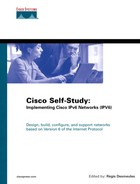Summary
This chapter examined IPv6 support on some of the most common host operating systems such as Microsoft, Solaris, FreeBSD, Linux, and Tru64. The discussion covered lists of applications, utilities, tools, and open software applications that are already available with IPv6 support on these platforms.
More specifically, you learned to install, enable IPv6 support on, and activate stateless autoconfiguration on Windows NT, Windows 2000, Windows XP, Solaris 8, FreeBSD 4.x, Linux RedHat, and Tru64. Then you learned how to manage IPv6 addresses and routes on these operating systems using the IPv6-enabled tools.
You also examined the transition and coexistence mechanisms that are supported on Microsoft, Solaris, FreeBSD, Linux, and Tru64 such as configured tunnel and 6to4. You saw the basic configuration commands and steps to establish configured tunnels between Microsoft, Solaris, FreeBSD, Linux, Tru64, and Cisco routers. Then you learned how to enable and configure the 6to4 mechanism on Microsoft, FreeBSD, and Linux platforms to interact with Cisco routers.
Throughout this chapter, you have seen examples of router configurations (Cisco IOS Software commands) applied on Cisco routers to enable stateless autoconfiguration, configured tunnel, and 6to4. Now that you understand IPv6 support on Microsoft, Solaris, FreeBSD, Linux, and Tru64, you can deploy and manage IPv6 networks based on Cisco routers and these hosts as nodes.
